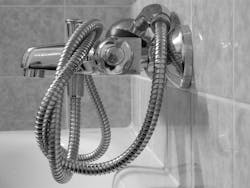A new report from the NAHB using U.S. Geological Survey data says residential areas are responsible for less than 8 percent of water used in the U.S., totaling 27,400 million gallons per day (Mgal/d). Average annual water use in the U.S. is 355,000 Mgal/d, with 260 gallons per day per single housing unit, varying widely from state to state. For example, Maine uses 100 gallons per day per housing unit, while Nevada uses 472 gallons of water per day. Generally, homes use more water in states that are hot, dry, and have larger households.
Indoors, the biggest water users are toilets, followed by showers, faucets, washing machines, and plumbing leaks. Homes built before 1960 tend to use less water, and average water use only slightly varies among single-family homes built after 1960. Newer homes tend to use more water, as they’re more likely to have water softener or filtration systems and in-ground sprinklers.
The Water Research Foundation’s models and NAHB’s analysis concluded that the price of energy is a greater determinant for usage levels than features installed by a home builder.
As for plumbing fixtures, the most recent NAHB Homebuyer Preference Survey shows that multiple shower heads in the master bath ranks 7th out of 16 bath features deemed essential or desirable by more than half of recent and prospective homebuyers. Drinking water filtration systems rank 6th out of 31 kitchen features, and are rated as essential or desirable by 70 percent of recent and prospective homebuyers.
